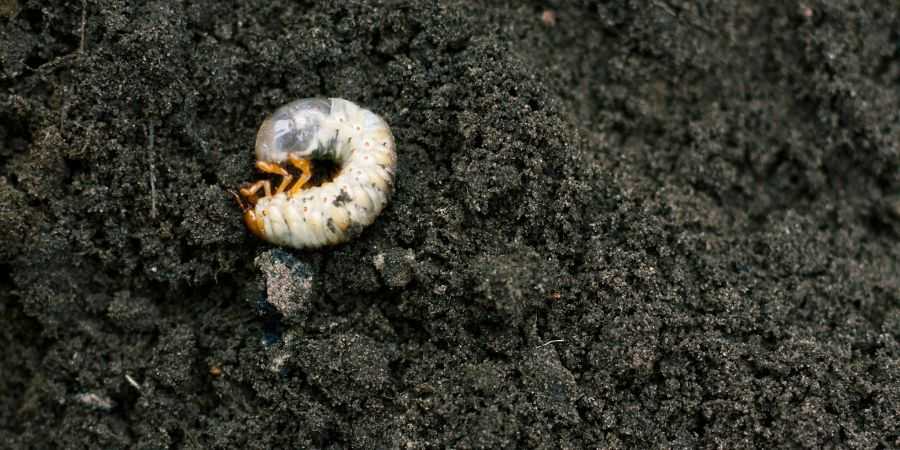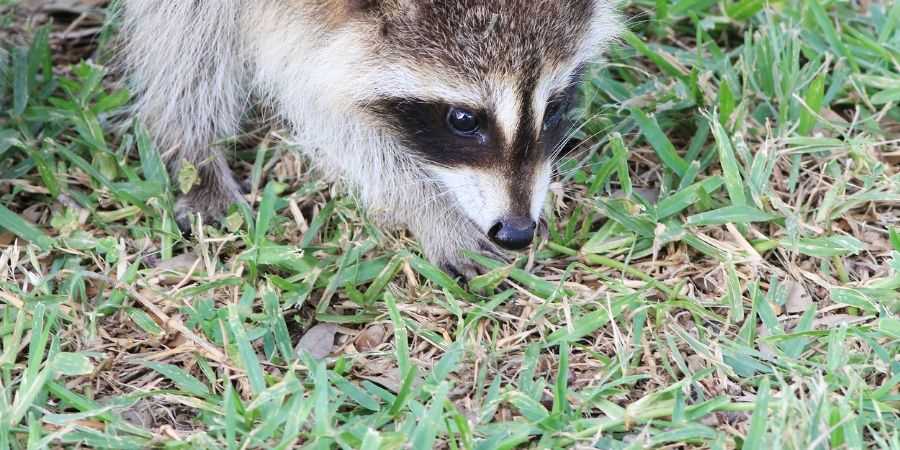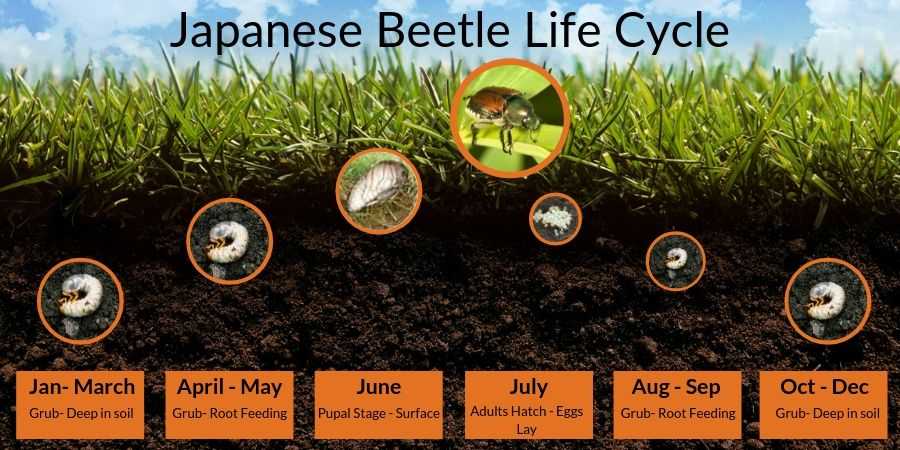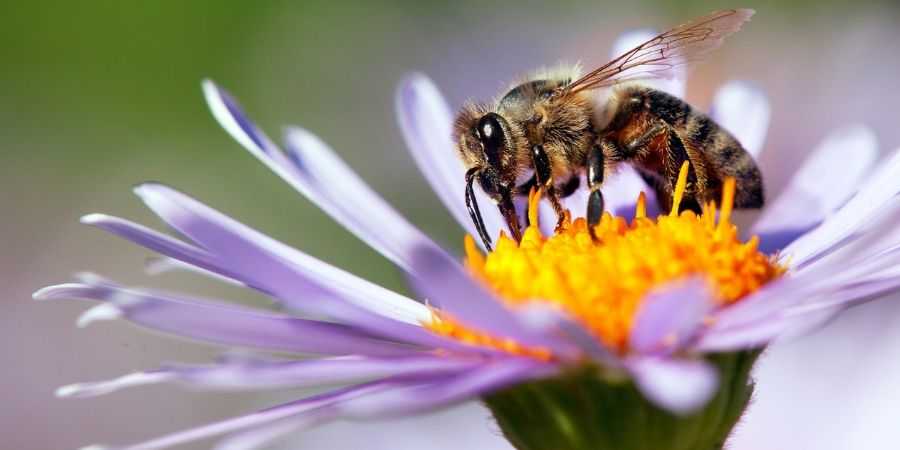Does My Lawn Have Grubs? How to Identify and Treat for Lawn Grubs
- Milorganite AgronomistJune 8, 2019
Winter is warming into spring and you notice a brown patch or two in your lawn, especially in areas where the lawn is already thin or struggling. The problem may be grubs. You’ll likely notice grub damage in March to early-May and/or mid-September to November.
So, what’s a grub? It’s the white, C-shaped larvae of European chafers, Japanese beetles, June beetles, as well as other beetles, and is about three-quarters-of-an-inch long. Grubs lay their eggs in soil under turf, where there’s an ample supply of organic matter in the soil to eat, including grass roots.

Before you head to the store to buy grub-control products for the lawn, a little detective work is needed to determine the cause of the brown patch: grubs or a lawn disease. Treating for the wrong lawn problem is unnecessary, ineffective, a waste of time and money, and may negatively impact the environment.
There isn’t a one-time treatment that’s going to get rid of grubs in the lawn. Effective treatment will take a year or two.
Preventive methods of grub control work best, such as maintaining a thick, healthy lawn by fertilizing regularly with Milorganite. Healthy turf may not prevent every grub from dining on roots under your lawn, but it will be much better able to withstand a half-dozen or so grubs per square foot. The low number of grubs may not even require treatment.
Dethatching and aerating your lawn helps to remove heavy thatch, reducing the grubs’ food source. It also increases the ability of water, air and nutrients getting to your lawn’s root system and improving its vigor.
How do you know grubs are causing damage to your lawn?
There are several indications that the brown patch in your lawn is caused by grubs:
- grub-loving birds and animals, including raccoons, skunks, and moles, are digging up your lawn; and,
- areas of the lawn feel squishy, like freshly laid sod, caused by grubs are eating away at the roots.

To determine if it’s really a grub problem and not a lawn disease, remove a one-square-foot patch of the damaged lawn to a depth of about 2”, as well as a few areas of the lawn that are green and healthy. If you only see a few grubs, it may not be necessary to treat, especially if the turf is healthy. If you find six or more in a square foot, it’s probably time for insecticide treatment.
Breaking the Japanese Beetle's Lifecycle
Breaking the beetles’ annual lifecycle is key to controlling grubs in your lawn. Understanding their lifecycle will help you identify the best time for treatment and what product to use.
Spring: As the weather warms, grubs migrate upward where they transform into adult beetles.
Summer: Beetles emerge in early-summer and eat plants throughout the garden. They lay their eggs in the lawn and in late-summer, around August, the grubs emerge and begin feeding.
Fall: Larvae will continue to eat and grow fat through mid-fall.
Winter: Grubs move 2–6” below the soil’s surface to survive winter.

Grub Control
There are a lot of products on the market for grub control and picking the right one can be confusing. Some are very effective, while others don’t address the problem at all. The key is to identify the active ingredient to determine whether it will be effective.
There are several active ingredients used in grub-control products on the market. Unfortunately, there’s no single insecticide application that’s going to eliminate grubs. It can take applying a couple of products over a year or two to remedy the problem.
When to apply insecticides depends on the grub’s lifecycle and product used. For best results, thoroughly water-in all products immediately after application with at least a half-inch of water. This gets the product into the soil where grubs are feeding and removes the product from grass blades, making the lawn safe for kids, pets, and wildlife after it dries.
Carefully follow all manufacturer instructions for use, especially the amount of product to use—more is not better. Adhere to all municipal restrictions on the use of insecticides on lawns to help protect the environment.
Grub Prevention
Prevention is the most effective method for controlling grubs. A healthy lawn is the best preventive method and better able to withstand a moderate number of grubs. Stressed lawns are an invitation for beetles to lay their eggs. Fertilize with Milorganite regularly to maintain a thick, healthy lawn and cut the grass to the proper length for the variety.
If you identified grubs the previous fall or spring, you may want to treat your lawn in spring with a preventive insecticide for a year or two. Even if you treated to kill the grubs last season, it won’t prevent the next generation of grubs from hatching and munching on your lawn’s roots. If you’ve already been treating your lawn for a couple of years and haven’t seen signs of any more grubs, you can stop.
Preventive insecticides are used to prevent future grub problems, not for current infestations. They are best applied in spring to early-summer and will prevent grub damage in fall and the following spring.
Entomologists at Michigan State University stated, imidacloprid, thiamethoxam, clothianidin are very effective preventive insecticides and can reduce the next generation of grubs by 75–100%. Although the recommendation for applying products containing these active ingredients may indicate a longer application period, we suggest applying and watering-in these insecticides May through July for maximum impact. If applied too late, they may not work as well.

To protect bees and other pollinators, cut your lawn before applying products containing imidacloprid, thiamethoxam, clothianidin to eliminate flowering weeds. If there are no flowering weeds, there’s no need to mow before application.
Another preventive insecticide active ingredient, chlorantraniliprole, is less water soluble, can be applied after the grass turns green and consistently reduces grubs by about 65%. It can be applied as early as April through mid-July and is most effective when applied before June. For fall control, it should be applied in April or May. It’s safe for bees, even if flowering weeds are treated.
Curative
Curative insecticides are used when grubs are present in the turf and are less effective than preventive treatments. The effectiveness of curative insecticides varies greatly; they may reduce populations by as little as 20% to as much as 80%.
There are only two active ingredients that are considered curative treatments for grub control: carbaryl and trichlorfon. Both are effective in killing all life-stages of grubs and are your only curative options. They’re best applied in fall or spring, but not after mid-May when grubs have stopped feeding as they prepare to pupate. Like the preventive insecticides, lawns should be mowed to remove flowering weeds immediately before applying carbaryl or trichlorfon to protect bees.
Active Ingredients that DO NOT WORK ON GRUBS
Carefully read product labels to determine the active ingredient/s. Follow the manufacturer instructions and community guidelines for use.
After you have the grubs under control, you’ll need to repair the affected patch of lawn to help prevent a recurring problem.
Summary
After you identify that grubs are the culprits causing brown patches in your lawn, choose either a preventive or curative insecticide for treatment, depending on the grubs’ lifecycle. If your lawn is healthy and there are only a small number of grubs, you may not need to treat at all.
Be patient. It’s going to take a year or two to get the grubs under control.

